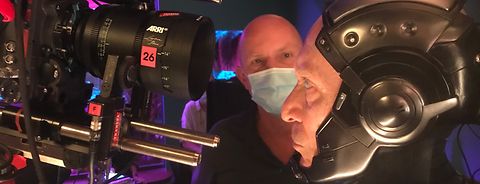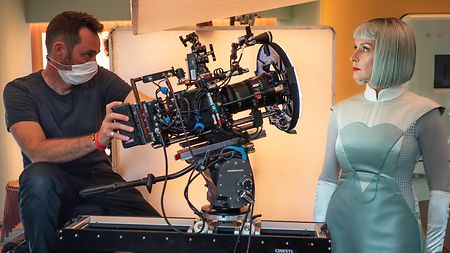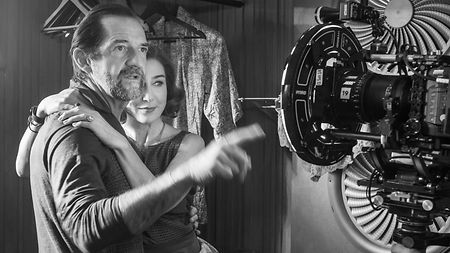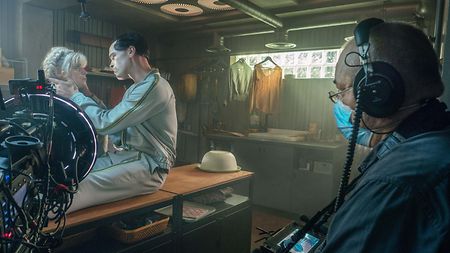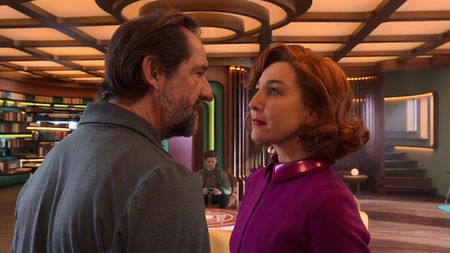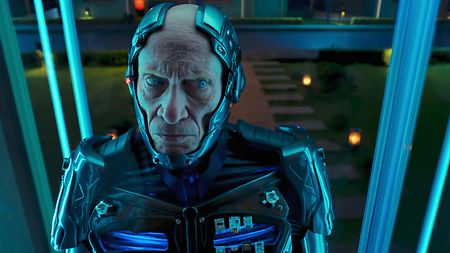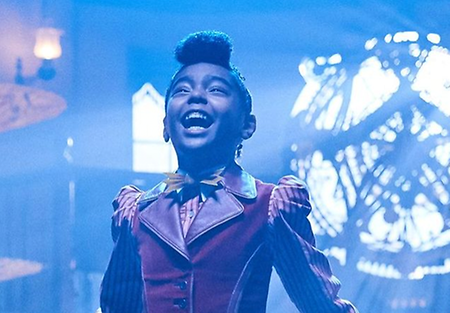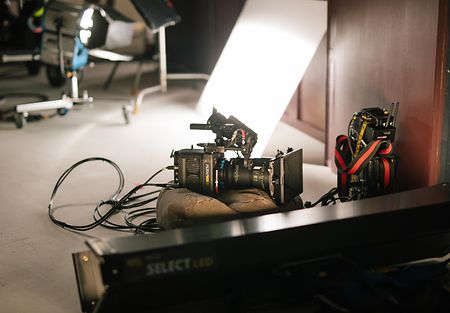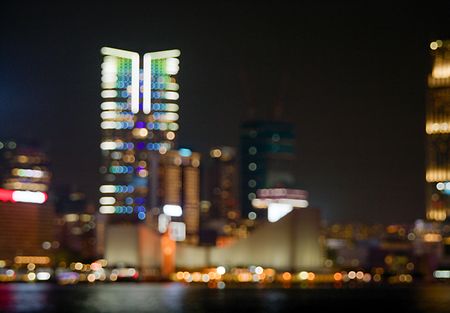Actors Stéphane De Groodt and Elsa Zylberstein shooting “Bigbug”
Mr. Hardmeier, it’s the second time that you shoot with Jean-Pierre Jeunet. Did he have any particular requests for the shooting of “Bigbug”?
It’s been almost four years since he told me about this project, which was difficult to put together as a feature for cinema. It’s a science-fiction comedy in the style of Jeunet, with confrontational humans and robots in a suburban house in 2050. Since we were shooting in a studio in a single set, he wanted a lighted ceiling to speed up the lighting set-up and allow more time for directing. I therefore worked very closely with Aline Bonetto, the production designer, who did an extraordinary job to find technical and aesthetic solutions.
What solutions did you implement for lighting?
I know from experience that Jean-Pierre likes to have warm tones in the image. He didn’t want to make a film with the usual cold colors of science fiction. For the lighting, we had the ceiling as a basis, lit by 93 SkyPanel S60s, and, with Aline Bonetto, we integrated a lot of other LEDs in the set, whether they were LED ribbons or flexible plates. This allowed me to structure the backgrounds. Then, to avoid being monochrome, I played with the color of these different sources: green, blue, yellow, fuchsia, etc. Any excuse was good for me to create color contrasts in the image. A week before the start of the shoot, Jean-Pierre and I conducted tests with the actors in costume and on set, in order to work in detail on the tints, the lights, and to create predefined atmospheres. All the LEDs, including the SkyPanels and the game lights, were adjustable from a console. It was great! I could control everything remotely and see the results right away. It was very intuitive. It freed up a lot of creativity for me and Jean-Pierre.
ALEXA Mini LF on set of the Netflix movie “Bigbug” by Jean-Pierre Jeunet
Geoffroy Saint-Hilaire behind the ALEXA LF
Why did you choose the ALEXA LF and the ALEXA Mini LF to shoot “Bigbug”?
I wanted to shoot the film in large format. At first I thought about using the ALEXA 65, but Jean-Pierre Jeunet likes to shoot in short focal length, with the actors in the foreground and a lot of depth of field. Since I only shoot with ALEXA, I chose to work with the ALEXA LF. On set, we had an ALEXA LF on a dolly and an ALEXA Mini LF on Steadicam, with Geoffroy Saint-Hilaire operating. We used both camera bodies interchangeably. For me, the ALEXA LF is a direct continuation of the classic ALEXA. It brings a real comfort of work when we are in the frame and it offers many accessory options. As far as the image is concerned, if I want to get information in the dark, there is clearly only the ALEXA. Not to mention its soft rendering and wide exposure latitude. All this is found in the ALEXA LF. Moreover, working in large format allowed me to gain focal length ratios. Most of the time, Jean-Pierre Jeunet works with 18 or 21 mm in S-35 mm, never with long focal lengths. A large part of “Bigbug” is shot at 25 mm, but thanks to the large format of the ALEXA LF, it looks like 16 mm, but without any distortion. It was the perfect camera for “Bigbug.”
Geoffroy Saint-Hilaire at the frame and the ALEXA LF
In terms of optics, what did you think of the ARRI Signature Primes?
For me, the ARRI Signature Primes are a direct continuation of the Master Prime, but adapted to 4K. They are very sharp and it is the kind of image that Jean-Pierre Jeunet likes in his films. I did some testing though. I compared the ARRI Signature Primes with other large format lenses. The ARRI series was the only one to be perfectly sharp and to offer me the best minimum point. I shot “Bigbug” with a 5.6 or 8 stop to get the maximum depth of field while having the characters in focus in the foreground. To gain an extra stop, I exposed the ALEXA LF at 2000 ASA.
ARRI Signature Primes and actors Stéphane De Groodt and Elsa Zylberstein
What are the advantages of HDR?
In post-production, we graded “Bigbug” in HDR, but also made a version in SDR. The advantage of HDR is the greater latitude it offers at the image level. In particular, it allowed us to preserve more details in the highlights. On this film we had a lot of practicals in the field. For this reason, we slightly dimmed the HDR effect, so as not to be too distracted by those highlights that would have become too strong in the image.
ALEXA LF, director Jean-Pierre Jeunet and actors Isabelle Nanty and Alban Lenoir on the set of the film “Bigbug”
How was working with Netflix?
Very good. We had total freedom on “Bigbug.” For the last two years, it just so happened that I have been working a lot with them on multiple projects. Netflix gives the directors and crews the means to work well, and they are very concerned about making sure everything goes well on the shoot.
